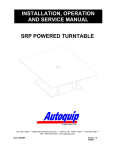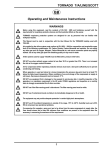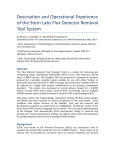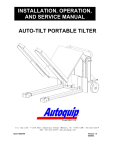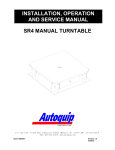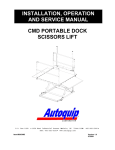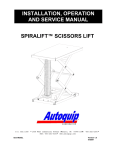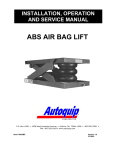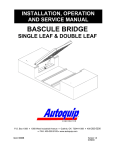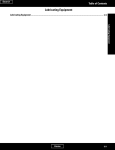Download Air Force Lift Installation, Operation and Service Manual
Transcript
INSTALLATION, OPERATION AND SERVICE MANUAL AIR FORCE LIFT P.O. Box 1058 Item # 830AFB • 1058 West Industrial Avenue Guthrie, • OK 73044-1058 • FAX: 405-282-8105 • www.autoquip.com 405-282-5200 • Version 1.0 02/20/01 TABLE OF CONTENTS Identification and Inspection 3 Dangers and Warnings 4 Label Identification 6 Specifications 10 Lift Blocking Instructions 11 Installation Instructions 12 Operating Instructions 13 Routine Maintenance 14 General Maintenance 15 Replacement Parts List 20 Troubleshooting Analysis 21 IMPORTANT Please read and understand this manual prior to installation or operation of this lift. Failure to do so could lead to property damage and/or serious personal injury. If any questions arise, call a local representative or Autoquip Corporation at 1-888-811-9876 or 405-282-5200. PLANNED MAINTENANCE PROGRAM A local Autoquip representative provides a Planned Maintenance Program (PMP) for this equipment using factory-trained personnel. Call a local representative or Autoquip Corporation at 1-888-811-9876 or 405-282-5200 for more information. 2 IDENTIFICATION & INSPECTION IDENTIFICATION When ordering parts or requesting information or service on this lift, PLEASE REFER TO THE MODEL AND SERIAL NUMBER. This information is on a nameplate attached to the leg assembly. Replacement parts are available from a local Autoquip distributor. INSPECTION Immediately upon receipt of the lift, a visual inspection should be made to determine that it has not been damaged in transit. Any damage found must be noted on the delivery receipt. In addition to this preliminary inspection, the lift should be carefully inspected for concealed damage. Any concealed damage found that was not noted on the delivery receipt should be reported in writing to the delivering carrier within 48 hours. The following is a checklist that will aid in the inspection of this lift. 1. Examine the entire unit for any signs of mishandling. 2. Pay special attention to the air bag and hosing. 3. Thoroughly examine all connections, making sure they have not vibrated loose during transit. 4. After installation, raise and block the lift and inspect the base frame, scissors assembly and air bag. See the “Lift Blocking Instructions” section. 3 DANGERS, WARNINGS & CAUTIONS Read and understand this manual and all labels prior to operating or servicing this lift. All labels are provided in accordance with ANSI Z535.4. DANGER! Do not work under lift without maintenance device! To avoid personal injury, NEVER go under the lift platform until the load is removed and the scissors mechanism is securely blocked in the open position. See the “Lift Blocking Instructions” section. DANGER! To avoid personal injury, stand clear of scissors leg mechanism while lift is in motion. DANGER! Do not inflate air bags to more than 80 PSI. 4 DANGERS, WARNINGS & CAUTIONS WARNING! NEVER stand, sit or ride on the lift! WARNING! All warning and information decals should be in place as outlined in the “Label Identification” section. If decals are missing or damaged, they should be replaced with new ones. Contact an Autoquip representative for replacements. CAUTION! When moving the lift, do not attempt to pick it up by the platform; it is hinged and could be damaged. Pick up from under the base frame ONLY. CAUTION! Do not continue to activate the “UP” valve if the lift is not raising or if it has reached the fully raised position. To do so may result in permanent damage to the lift. 5 LABEL IDENTIFICATION Figure 1 Label Placement Diagram Air Force Lift Label Information Item No. 1 2 3 4 5 6 7 8 9 Qty 2 2 2 1 1 1 1 2 2 Description Danger – Do Not Put Hands or Feet . . . Max. Capacity Caution – Familiarize Yourself with Operators Manual Do Not Inflate To More Than 80 PSI Leg Socket Maint. Device Autoquip Serial Number Nameplate Lifting Capacity vs. Air Pressure (model 24AF25) Lifting Capacity vs. Air Pressure (model 24AF50) 6 Part No. 36430050 36405710 36401487 36401628 36400265 36400257 36401511 36405810 36405820 LABEL IDENTIFICATION Note: Labels shown here are not actual size. Figure 2 Label 36430050 Figure 3 Label 36405710 Figure 4 Label 36401487 Figure 5 Label 36401628 7 LABEL IDENTIFICATION Figure 6 Label 36400265 Figure 7 Label 36400257 Figure 8 Label 36401511 8 LABEL IDENTIFICATION LIFTING CAPACITY vs. AIR PRESSURE 3000 S D N U O P 2500 RATED CAPACITY = 2500# ~ Y T I C2000 A P A C 80 PSI (MAX. OPERATING R PESSURE) G1500 N I T F I L 1000 60 PSI 40 PSI 500 0 0 6 12 LIFTTRAVEL ~INCH ES 18 24 Figure 9 Label 36405810 LIFTINGCAPACITYvs. AIRPRESSURE S 6000 D N U O P 5000 ~ RATED CAPACITY = 5000# Y T I C4000 A P A C 80 PSI (MAX. OPERATING P RESSURE) 60 PSI G3000 N I T F I L 2000 40 PSI 1000 0 0 6 12 LIFT TRAVEL ~INCHES Figure 10 Label 36405820 9 18 24 SPECIFICATIONS Model # Capacity Base Frame (Max Size Lbs.) Travel Shipping Max. Under Platform Lowered Raised clearance for No. Of Operating Weight Sizes Height Height Pallet Jack Airbags Pressure (pounds) 24AF25-1 24” 2,500 36 x 48” 36 x 48” 9.5” 33.5” 3.38 1 80 psi 820 24AF25-2 24” 2,500 36 x 48” 48 X 48” 9.5” 33.5” 3.38 1 80 psi 860 24AF25-3 24” 2,500 36 x 48” 48 X 54” 9.5” 33.5” 3.38 1 80 psi 880 24AF25-4 24” 2,500 36 x 48” 48 X 60” 9.5” 33.5” 3.38 1 80 psi 900 24AF50-1 24” 5,000 36 x 48” 48 X 48” 9.5” 33.5” 3.38 2 80 psi 880 24AF50-2 24” 5,000 36 x 48” 48 X 54” 9.5” 33.5” 3.38 2 80 psi 900 24AF50-3 24” 5,000 36 x 48” 48 X 60” 9.5” 33.5” 3.38 2 80 psi 920 LOADING The scissors lifts have the load capacity rating stamped on a metal plate attached on one side of the lift. This figure is a net capacity rating for a lift furnished with the standard platform. In the event that gravity-roll sections, special tops, etc., are installed on the lift after leaving the plant, deduct the weight of these from the load rating to obtain the net capacity. Damage may result if the lifts are overloaded beyond the established capacity UNBALANCED LOADING The stabilization provided is basically for balanced loads. Due to the fact that the lift is designed to operate without having to be lagged to the floor, special attachments that extend beyond the length and/or width dimensions of the platform should be avoided. This will prevent unintentional tipping of the lift that could lead to damage of the equipment or personal injury. 10 LIFT BLOCKING INSTRUCTIONS 1. Remove all load from the platform. Never block the lift when loaded, only when empty. 2. Raise the lift platform sufficiently to install the maintenance leg. 3. Begin lowering the platform by activating the “DOWN” valve until the maintenance leg is captured by the socket on the underside of the platform and the locating disc on the base frame. Continue activating the “DOWN” valve five to ten seconds to relieve the air pressure in the air bag. 4. Always shut off the main air supply, when blocked, to prevent someone from turning it on. 5. To remove the maintenance leg, raise the platform by activating the “UP” valve to provide sufficient clearance for the removal of the maintenance leg. WARNING! To avoid personal injury, NEVER go under the lift platform until the load is removed and the scissors mechanism is securely blocked in the open position. 11 INSTALLATION INSTRUCTIONS 1. Make sure installation area is clean before starting. 2. If the permanent air supply work is not complete, some means of temporary lines with an on-off device for the air supply should be set up for testing purposes. 3. Place the lift in the installation area. CAUTION! When moving the lift do not attempt to pick it up by the platform; it is hinged and could be damaged. Pick up from under the base frame ONLY. 4. Make temporary air connections. Raise the lift to the top of its travel and make positioning adjustments. Check for the proper height. If needed, shim to the desired height. WARNING! Block scissors mechanism in the raised position prior to working under lift. See the “Lift Blocking Instructions” section. 5. If the decision is made to lag the lift to the floor, the base frame of the lift has predrilled holes for lagging the lift. Mark the holes, drill, and install with anchors. 6. Make permanent air connections and operate the lift through a few cycles. 7. Clean up any debris from the area. A clean installation makes a good impression and creates a much safer environment! WARNING! All DANGER, WARNING, and CAUTION labels and informational decals and plates must be intact and in place on the lift. Contact an Autoquip representative if labels are missing or damaged. See the “Label Identification” section. 12 OPERATING INSTRUCTIONS 1. Scissors lifts have a maximum lifting capacity (see “Specifications” section). The safety relief air valve has been factory set to open at a point slightly above the rated load and allows the air to bypass into the atmosphere. Lowering loads exceeding the rated capacity of the lift may result in excessive wear and damage to the lift. 2. This type of lift is designed primarily for in-plant applications and is furnished with constant pressure foot valve or hand valve controls. Actuating the "UP" valve will cause air to enter the air bag and the lift will rise. 3. When the desired height or upward travel of the platform is attained, removing the operators’ foot or hand from the valve deactivates the “UP” valve. The air stops flowing into the bag and the upward movement will stop. 4. To lower the lift, activate the "DOWN" portion of the control valve, which allows air to exhaust to the atmosphere. Opening the down control valve allows the air in the air bag to flow through the down valve at a controlled rate and exhaust to the atmosphere. 5. When the desired height or downward travel of the platform is attained, removing the operator’s foot or hand from the valve deactivates the “DOWN” valve. The air stops flowing from the bag and the downward movement will stop. CAUTION! Do not continue to activate the "UP" valve if the lift is not raising or if it has reached the fully raised position. To do so may result in permanent damage to the lift. 13 ROUTINE MAINTENANCE Normally scissors lifts will require very little maintenance. However, a routine maintenance program could prevent costly replacement of parts and/or downtime. WARNING! To avoid personal injury, NEVER go under the lift platform or perform any maintenance on the lift until the load is removed and the scissors mechanism is securely blocked in the open position. See the "Lift Blocking Instructions" section. Monthly inspection should consist of the following: 1. Check for visible air leaks; correct as necessary. 2. Check any unusual noise when it occurs. Determine the source and correct as necessary. 3. Check the snap rings at all rollers, if not in place, and/or secure, replace or repair immediately. 4. Check all rollers for signs of wear. Replace as necessary. 5. Do not grease roller or axles; they have lifetime-lubricated bearings. 6. The lift has a safety relief valve, which is factory pre-set. The relief valve should not be adjusted for any reason as it could cause the lift to fall uncontrollably. 14 GENERAL MAINTENANCE AIR BAG REMOVAL AND REPLACEMENT WARNING! To avoid personal injury, NEVER go under the lift platform until the load is removed and the scissors mechanism is securely blocked in the open position. See the "Lift Blocking Instructions" section. 1. Engage the maintenance leg. See the "Lift Blocking Instructions”. 2. Continue to hold the “DOWN” valve after the lift has stopped traveling downward to relieve the system air pressure. 3. Disconnect the air bag by removing the four bolts that attach the bag to the base and leg assembly. 4. Remove the air bag hosing and remove the bag from the lift. 5. Re-installation of air bag assembly is the reverse of above procedure. 6. After checking all pins, mechanical components, and air control components to make sure everything is completely assembled and in working order, it is a good idea to check the lag bolts for tightness. 7. Turn on the air supply and press the "UP" valve. Raise the lift and check for any air leaks. If everything checks out all right, remove the maintenance leg (see the “Lift Blocking Instructions” section). 8. Cycle the lift 10 to 15 times to ensure it is working properly. 9. LAST BUT NOT LEAST! Clean up the area. It’s part of the job as a service technician and reflects on the work performed. NOTE: This job should require one to two hours of time, depending on the experience of the service technician. 15 GENERAL MAINTENANCE Figure 11 Foot Valve Connections 16 GENERAL MAINTENANCE Figure 12 Pneumatic Schematic 17 GENERAL MAINTENANCE LIFTING CAPACITY vs. AIR PRESSURE 3000 S D N U O P 2500 RATED CAPACITY = 2500# ~ Y T I C 2000 A P A C 80 PSI (MAX. OPERATING PRESSURE) G1500 N I T F I L 1000 60 PSI 40 PSI 500 0 0 6 12 LIFTTRAVEL ~INCHES 18 Figure 13 Lifting Capacity vs. Air Pressure (Model 24AF25) 18 24 GENERAL MAINTENANCE LIFTING CAPACITY vs. AIR PRESSURE S 6000 D N U O P 5000 ~ RATED CAPACITY = 5000# Y T I C4000 A P A C 80 PSI (MAX. OPERATING PRESSURE) 60 PSI G3000 N I T F I L 2000 40 PSI 1000 0 0 6 12 LIFTTRAVEL ~INCHES 18 Figure 14 Lifting Capacity vs. Air Pressure (Model 24AF50) 19 24 REPLACEMENT PARTS LIST Part Number 40730750 41401159 41401600 41701368 47900006 52504781 52504790 52601590 Description Airbag Actuator 3-way, 3-position _” air valve, foot operated Foot Guard Relief Valve; 50-200 PSI Breather Plug, _” hex Clevis Pin, 7/8” x 1_” Roller Axle Pin, 1 1/8” Roller Assembly with Bushing 20 TROUBLESHOOTING ANALYSIS WARNING! To avoid personal injury, NEVER go under the lift platform until the load is removed and the scissors mechanism is securely blocked in the open position. See the "Lift Blocking Instructions" section. PROBLEM Lift does not raise POSSIBLE CAUSE AND SOLUTION • The load may exceed the rating for the specific line pressure. Refer to the performance curves shown in the “Lifting Capacity vs. Air Pressure” curves in the “General Maintenance” section. • There may not be enough, or any, line pressure. Check the supply pressure with a gauge and ensure it provides the minimum pressures required as shown in the performance curves shown in the “Lifting Capacity vs. Air Pressure” curves in the “General Maintenance” section. • Make sure the air supply line is connected to the correct port on the hand or foot control valve. It is marked “Inlet”. • It may be that an obstruction was introduced into the system during installation. Check for obstructions at the inlet of the control valve, in the connecting hose to the lift, and at the restrictor in the bottom of the air bag. Lift drifts down slowly during non-operation. • Make sure all of the connections are tight and that no leaks are occurring in the system. Lift seems bouncy during operation. • This is normal for large volume (air bag) air-powered systems due to the compressible nature of air, (especially at raised elevations) between fully lowered and fully raised positions. 21 TROUBLESHOOTING ANALYSIS PROBLEM Lift raises very slowly. POSSIBLE CAUSE AND SOLUTION • The primary cause of slow actuation in airpowered systems is a lack of air volume (cubic feet per minute (CFM) to the lift. Determine the air volume of the air supply system/ compressor. For the lift to operate at reasonable speeds (2030 seconds raising time), the lift needs to have a minimum of five CFM. • Make sure all connections are tight and that no leaks are occurring in the system. • It may be that an obstruction was introduced into the system during installation. Check for obstructions at the inlet of the control valve, in the connecting hose to the lift, and at the restrictor in the bottom of the air bag. Lift does not lower, or lowers very slowly. • Make sure the inlet, outlet, and exhaust lines are connected to the correct ports on the hand or foot control valve. • It may be that an obstruction was introduced into the system during installation. Check for obstructions at the outlet of the control valve, in the exhaust line from the control valve (if applicable), or in the connecting hose to the lift. • Make sure the if the lift was raised and blocked open for maintenance that the flip-over maintenance locks were removed from the path of the lift rollers and placed back in the “home” position. 22






















